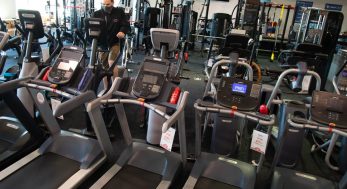
(Photo by A. Grimm/FC Bayern via Getty Images)
I’ve recently made a ritual of mat Pilates classes on Monday nights. They’re offered at the gym where I lift weights a few times a week, and were already factored into my membership. Deciding I ought to maximize my sort-of-steep monthly rate, I rolled in last month for my first foray into a world of pumps, magic circles and plank rocks.
Mat Pilates, as the name suggests, eschews the famous and somewhat complex reformer equipment for a variety of exercises performed on a mat, some while lying supine or prone, others while standing up. The pace and style of the class varies from instructor to instructor — we had a substitute one day who must’ve had a bad day, and took it out on us with six progressively-more-challenging plank poses. The necessary “tools” change too, based on what muscle groups are being targeted. One day, for instance, we used shower towels as a makeshift head “parachute” while doing sit-ups: you hold the top two corners of the towel against the back of your head, which ensures the sit-up motion will be completed with the core alone, protecting the neck.
Much of Pilates is concerned with minute, seemingly innocuous corrections. The commands to achieve them sometimes make little sense (“Divert more air into the area around your lower back”; “Try to soften your sternum”), but in a class setting, you’ll be damned if you don’t at least try. I’ve found, when in doubt, it pays to keep your neck aligned with your spinal cord, stick your butt out a little farther and keep breathing — inhale through the nose, hold it for a beat, exhale out the mouth. The process demands concentration, and by extension, a rare brand of mindfulness. If you’ve heard the buzzphrase “mind-body workout,” this is the sort of routine it’s referring to.
The second time I visited a class, my instructor (who walks around the room and helps everyone nail down the correct posture for each move) poked at my shoulders. He encouraged me to contract them back, and, as if realizing something, asked me if I hunched over a computer all day. Pretty educated guess: I’m a twenty-something who lives in Brooklyn. But I was also the only class member he said it to — ouch. I do, indeed, hunch over a computer for at least eight hours a day, and according to the screen time report on my iPhone, I hunch over my phone for two hours a day, too.
Related:
How to Fix Your Office Posture, in Four Steps
Why Every Nine-to-Fiver Should Be Taking a Daily Constitutional
This modern phenomenon is well-documented, and has a name. It’s called tech neck. Americans have added an hour of non-voice activity on mobile devices since 2013; we’re literally getting better at staring at screens, and the strain that puts on the neck is monumental. This diagram does a better job depicting it, but suffice to say, for every 15 degrees of forward tilt inflicted on the neck, the more weight it has to support. According to Dr. K. Daniel Riew, an orthopedic surgeon operating out of New York: “At just 45 degrees, your neck muscles are lifting the equivalent of a 50-pound bag of potatoes.”
And your neck muscles are lifting those potatoes for anywhere from five-to-eight hours a day, if not more. The strain puts more pressure on the discs in your back (which are already dehydrating as you age) and contributes to stress in spinal joints … which exacerbates low back pain, a symptom that historically affects 80% of the population. Basically, it’s one big mess, from your brain down to your behind. The sedentary lifestyles we all live aren’t helping, either. Kudos to the standing-desk folks, but the majority of us sit in chairs, and hunch in them because answering emails is frustrating enough without having to engage your core while doing so.
It’s important, though, to try and make corrections while in the office. Essentially, you want keep your computer screen within your eye-line, avoid posture correctors, take a mid-afternoon walk to get the blood pumping, and pepper in occasional discreet desk exercise, like neck extensions, toe points or wall angels. Getting into some healthy habits in the building where you spend most of your waking hours is always a good idea.
That said, your best bet is to incorporate the ethos into a sustainable fitness routine. A massive credo in Pilates is the word “elongate.” There’s a bit of pseudo-science behind it, as you can’t actually lengthen your muscles. Muscle length is determined by the points where muscles attach to the bone. It’s genetic. But you can increase their elasticity, or range of motion. Muscles get tighter as you get older, and addressing them with concerted stretching can open up those muscle fibers and help your muscles reach their maximum natural length. This, in turn, can help stem pain and stiffness in your back, inflammation in your joints, and all the invisible damage done from simply earning waking up to commute and make money in the 21st century.
I’d recommend Pilates, as a start. I may be a novice to it, but that’s more reason to trust me; I have no agenda here. Yoga works too, obviously, and so does nightly stretching and tissue work. Make it a part of your wind-down routine. Your body will learn to expect sleep and relax — which, by the way, is another crucial element wrapped up in all this. A favorable sleeping position — lying flat on your back — is a perfect time to have the neck aligned with the spine for hours on end. Tossing and turning isn’t doing you any favors.
I’d suggest bringing these concepts into your strength training, too. Apply time under tension (TUT), where you focus long and hard on a rep, and notice how hard work in the flexibility realm is directly related to more precise and perfect reps in the weightlifting arena. You’ll rely less on your back next time you’re supposed to be curling your biceps or bench pressing with your chest, which in turn will protect the spine. That’s really what this is all about. The term “elongate” is used to sell the idea of toned, lean muscles, which are great and can absolutely be achieved. But the spirit of that term is about treating the spine — unglamorous body part though it may be — with the attention and care it truly deserves.

